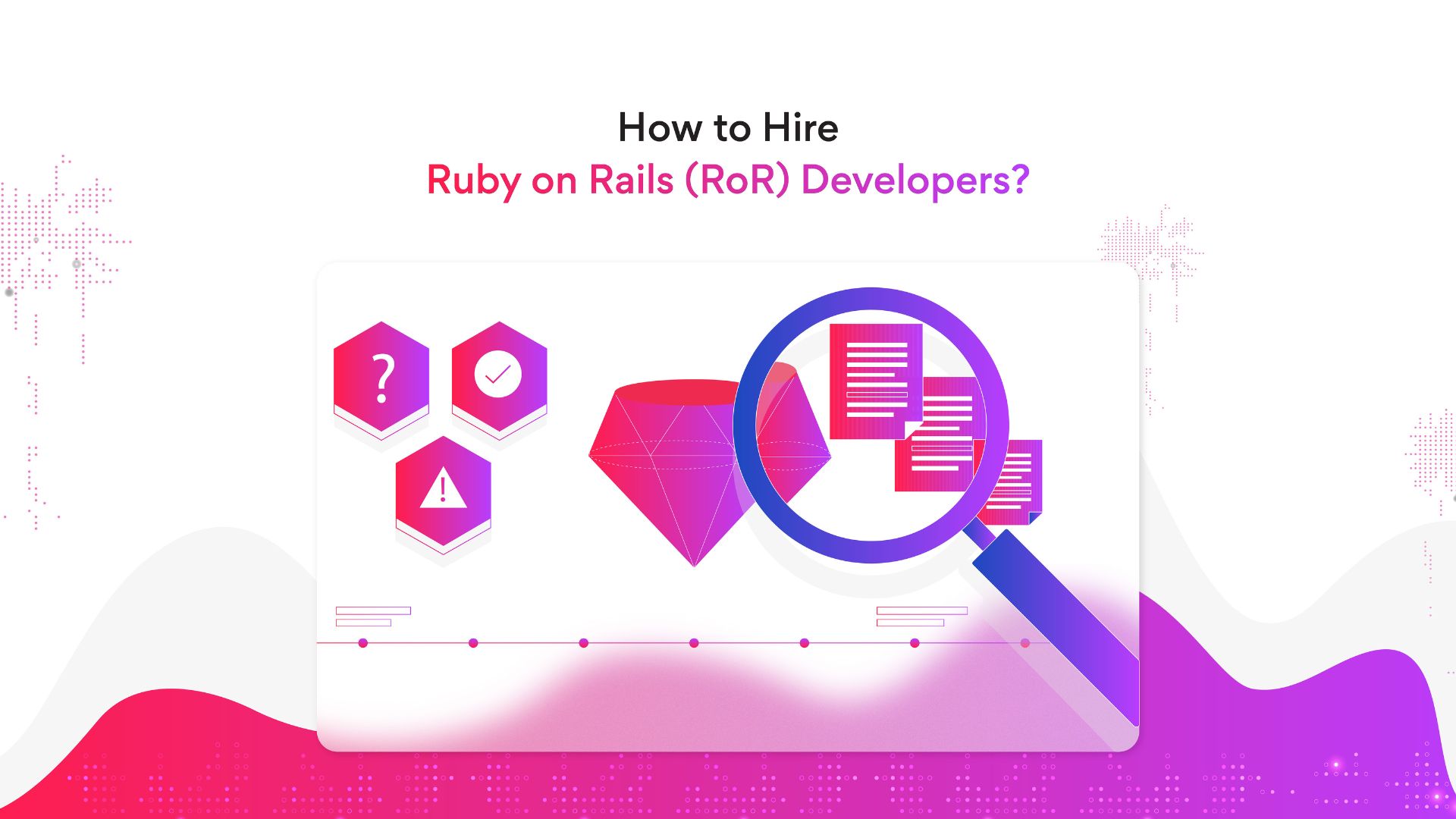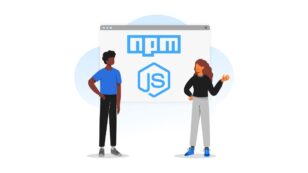Hire Ruby on Rails (RoR) Developers with These Steps!
How do I hire a Ruby on Rails developer? Keep reading to find out!
Ruby on Rails is a popular, open-source, client-side web application framework. The framework offers an expansive list of code libraries to build websites and web applications. It also provides robust default data structures for configuring databases, web services, and web pages. Ruby on Rails is a Model-View-Controller (MVC) framework that supports software development paradigms such as Convention over Configuration (CoC), don’t repeat yourself (DRY), etc.
Ruby on Rails was developed in 2004, using a programming language from 1995. The framework also allows active record patterns to store data across relational databases. RoR also allows faster web development through seamless data migrations, speedy table creations for databases, and ‘View Scaffolding’ options.
The framework’s popularity has created a large community of Ruby on Rails developers across the globe. More than a hundred thousand companies across the US use Ruby on Rails for their website development.
What is Ruby?
‘Ruby’ is a high-level, general-purpose programming language. Ruby is a dynamically typed, interpreted, multi-paradigm language that uses garbage collection. Ruby supports object-oriented, procedural, and functional programming and just-in-time (JIT) compilation.
Related Post: Ruby vs Python: What Is The Difference?
Ruby On Rails framework is based on the object-oriented programming language, ‘Ruby.’ A sound understanding of Ruby programming helps develop the RoR projects. Many programmers prefer Ruby due to its speed, flexibility, versatility, ease of learning, and high demand.
What are the advantages of Ruby on Rails?
Ruby on Rails is an in-demand web development framework with multiple advantages for companies and developers. Some of the main benefits of Ruby on Rails are as follows:
Advantages of Ruby on Rails for employers:
-
Reliability
Developers using Ruby on Rails can choose from multiple coding styles. Test codes in Ruby on Rails allow faster elimination of bugs. Thus, error-free websites made with RoR are reliable and easy to maintain. -
Affordability
Ruby on Rails is an open-source framework that eliminates licensing costs, making it a cost-effective option for businesses. RoR helps companies meet their timelines and maintain their budgets with faster code deployment. Ruby on Rails has features like DRY and Scaffolding that reduce developer efforts and overall development costs. -
Security
Ruby on Rails offers multiple in-built security features and tools within its code libraries. Ruby on Rails plug-ins, Authlogic and Devise, protect the data against cyber attacks. In addition, companies can implement Access Control through Ruby on Rails authorization libraries CanCanCan and Pundit. -
Higher productivity
Ruby on Rails framework is a versatile tool that ensures lesser code with minimum repetitions. Rails is highly readable and supports Rapid Application Development, making implementing changes easier. The framework supports testing automation, making deployment and development easier and faster.
Advantages of Ruby on Rails for developers:
-
Availability of resources
Ruby on Rails developers have access to more than 1.7 million ready-to-code RoR packages called ‘gems.’ The simple syntax of Ruby and self-documentation of Ruby on Rails make web development easy to learn and deploy code. -
Large community
A large community of Ruby on Rails developers is active across software development forums. The dev community is supportive and helps other RoR developers solve common programming and testing problems. Ruby on Rails developer community also helps integrate services and applications for Ruby-based websites. -
High demand
Ruby on Rails developers are in high demand among big companies and startups that use the RoR framework. More than four million websites use the Ruby on Rails framework, and around 800,000 websites in the United States run on Ruby on Rails. It is estimated that the demand for Ruby on Rails developers will increase by around 13 percent YoY, until 2028. -
Automated testing
The automated testing features of Ruby on Rails work well for developers. The features speed up the deployment and implementation of Ruby on Rails projects. Better testing enables developers to improve the debugging process and ensure accurate coding.
Related Post: 15 Best Front-End Frameworks for 2022
What are the requirements and responsibilities of Ruby on Rails Developers?
Hiring managers seek expert Ruby on Rails developers to work on back-end web development projects. Senior Ruby on Rails developers possess a versatile web development skillset, with expertise in performing front-end and back-end tasks. Junior Ruby on Rails developers understand the rudimentary concepts of Ruby, MVC, client-side database development, etc. Here are some of the main differences between junior and senior Ruby on Rails developers:
Junior Ruby on Rails Developers
Junior Ruby on Rails developers have a basic understanding of web development languages, platforms, and SDLCs. Most junior RoR developers are proficient in HTML, CSS, JavaScript, Bootstrap, and other web development technologies.
Junior Ruby on Rails developers know the syntax, features, and semantics of the Ruby programming language. To code with the Ruby on Rails framework, developers use different elements of Ruby such as loops, modules, gems, conditional statements, classes, etc. Junior Ruby on Rails developers need to know multiple aspects of Object-Oriented Programming (OOP).
In addition, junior Ruby on Rails developers must also possess good soft skills to collaborate with team members seamlessly. And so, hiring managers prefer recruiting junior RoR developers who possess an adequate blend of tech skills and soft skills.
Senior Ruby on Rails Developers
Most senior Ruby on Rails developers have 5+ years of experience. Senior RoR developers know how to use code management tools (Git), deployment tools (Heroku), and productivity tools.
Senior Ruby on Rails developers can structure the application and website using the Model-View-Controller (MVC). In addition, senior RoR developers can use ERB (Embedded Ruby) and HAML (HTML Abstraction Markup Language) for viewing systems. They can use ActiveRecord commands for data modeling, data migration, data association, and data validation.
In addition, senior Ruby on Rails developers have hands-on experience with RSpec, a modular testing tool. And senior RoR developers can use JSON format within Application Programming Interfaces (APIs).
Expertise in REST apps, HTTP statuses, and other web development tools is a prerequisite for senior Ruby on Rails developers. Moreover, most senior RoR developers have excellent soft skills, and are great team leaders.
Where can you hire Ruby on Rails developers?
Hiring managers can explore multiple options for hiring Ruby on Rails developers.
Some of the primary methods to hire RoR developers are as follows:
Job posting websites
Hiring managers can post the requirements for Ruby on Rails developers on job portals like Monster, Indeed, etc. But common job posting websites do not offer sophisticated vetting methods to gauge a candidate’s experience, soft skills, and expertise. In addition, job posting websites have many limitations, such as a long and slow hiring pipeline, a lack of automatic screening methods, and a lack of consistency.
Professional social networking platforms
Professional social media websites LinkedIn, Meetup, AngelList, etc., are alternative platforms to hire Ruby on Rails developers. But these platforms are often inefficient due to a high level of fluff, false endorsements and recommendations, and a lack of adequate assessment methods.
Hire Ruby on Rails developers with Turing.com
Turing is an Intelligent Talent Cloud that uses AI to vet, source, and match remote Ruby on Rails developers. And thus, Turing helps companies save 50+ hours of time required by engineering teams for hiring Ruby on Rails developers. In addition, Turing enables companies to hire the best Ruby on Rails developers from a planetary pool of over 1.5 million developers.
How to hire Ruby on Rails developers: A step-by-step guide
Step 1: Define your project requirements and budget
Hiring managers should coordinate with the software project heads to hire suitable Ruby on Rails developers. In addition, employers must carefully consider hiring timelines, deadlines, budgets, and the number of vacancies before making any decision.
Step 2: Evaluate portfolios to hire Ruby on Rails developers
Previous work experience reflects the software development proficiency of RoR developers. Thoroughly scan through the contribution level, project responsibilities, and turnaround times for hiring great Ruby on Rails developers.
Step 3: Technical skill assessment
Hiring managers can conduct technical assessments by asking applicants to complete Ruby on Rails coding challenges. Recruiters can also ask the following Ruby On Rails interview questions to assess the technical knowledge of applicants.
Interview questions to hire Ruby on Rails developers
Junior-level interview questions
-
What are the advantages of Ruby on Rails?
Some of the main advantages of Ruby on Rails are scalability, consistency, efficiency, security, and cross-platform support. RoR offers a bug-free web development platform with excellent testing capabilities.
Asking this question would help you understand why a candidate prefers Ruby on Rails over other web development frameworks. -
What are the disadvantages of Ruby on Rails?
The disadvantages of Ruby On Rails are rigidity, performance bottlenecks, and constraints. Due to the framework’s rigidity, any issues with data architecture that are detected late in the web development life cycle can lead to heavy costs of coding. Knowing these disadvantages would allow web developers to plan the feasibility of using Ruby on Rails early on. -
Mention a few features of Ruby.
Some of the features of the Ruby programming language are as follows:- Dynamic and duck typing
- Short and flexible syntax
- Object-oriented programming
- Metaprogramming
- Garbage collection
-
What is the application of the garbage collection feature in Ruby on Rails?
The garbage collection feature of Ruby on Rails ensures that the programmer does not need to manually relocate dereferenced memory. Garbage collection in RoR performs automatic memory management of data objects. Garbage collection eliminates coding errors such as wild pointers, double-free bugs, and memory leaks.
Senior-level Ruby on Rails interview questions
-
How does Ruby on Rails trigger AJAX Operation?
AJAX allows web pages to refresh automatically when the server reflects changes. Ruby on Rails can trigger AJAX operation when:- A change on the server level is initiated when trigger fires are launched with a button/link click.
- The web client calls upon the server while executing an XMLHttpRequest.
- The server sends an HTML fragment when triggered by a server-side action handler.
- Ruby on Rails generates client-side JavaScript, which receives and updates an HTML fragment within the page.
-
What are the uses of Ruby on Rails migration?
Ruby on Rails migration can rename a table, add a column, change or edit a column, drop a table, remove a column, and perform other similar operations. Ruby on Rails migration is used to change and update database schema over time. Using Rails migration makes your application database-independent, making it easier to switch platforms if required. -
What is CSRF? How does Ruby on Rails work against CSRF?
Cross-Site Request Forgery (CSRF) is a form of cyber attack used by hackers to damage or reveal confidential information. The protect_from_forgery command in Ruby on Rails Application Controller is helpful against CSRF attacks. This command generates CSRF tokens, verifying any post, put, or delete requests within your web application. -
What does the Rails controller do in Ruby on Rails?
Ruby on Rails controller handles the interaction between the model, views, and users. As a logic center, the controller routes external requests and performs corresponding internal actions. The controller regulates helper modules to operate view templates without unnecessary lines of code. Rails controller also regulates live sessions to inform users about their interaction with the system.
Step 5: Onboarding RoR developers
To ensure a smooth onboarding process, hiring managers must follow certain protocols. Some of the major steps involved in onboarding new Ruby on Rails developers are as follows:
- Hand over the paperwork and complete the documentation process.
- Share the access to productivity tools, software, and the Integrated Development Environment (IDE).
- Send a welcome email, and possibly a welcome package consisting of company-branded goodies.
- Introduce the candidate to the team members and team leader.
- Assign a teammate as their point of contact to clear doubts about their tasks, and help them understand the company culture.
How to hire Ruby on Rails developers for your company?
Companies must follow a clear and definitive hiring strategy to hire Ruby on Rails developers. Hiring managers must take into account multiple factors while selecting prospective employees. Employers consider factors such as experience, expertise, portfolio of RoR projects, GitHub repositories, and proficiency in Ruby to hire Ruby On Rails developers.
The complexity of the hiring process can be overwhelming. Turing makes hiring remote Ruby on Rails developers easy, fast, and cost-effective.
FAQs
-
How do I hire Ruby developers?
Hire Ruby developers with Turing’s Intelligent Talent Cloud. With Turing, you can hire pre-vetted, Silicon Valley-caliber developers at unbeatable prices in just 3-5 days! -
What is the cost of hiring a Ruby On Rails developer?
The cost of hiring Ruby On Rails developers can vary depending on their seniority, experience, and geographic location. A Ruby On Rails developer in the USA or Europe may cost up to a few hundred dollars per hour. In contrast, a Ruby On Rails developer in an Asian or Latin American country may cost somewhat lesser than that.
Hiring a remote Ruby on Rails developer can be a cost-effective solution. Turing can help you hire the best Ruby On Rails developers on a tight budget. -
Where can I find Ruby On Rails developers?
Finding Ruby On Rails developers on job listing websites and professional networking sites is a hit-or-miss approach. Find pre-vetted Ruby On Rails developers for your company with Turing.com. With Turing, you can hire the top Ruby on Rails developers from a talent pool of over 1.5 million developers across 150 countries in just 3-5 days.
Tell us the skills you need and we'll find the best developer for you in days, not weeks.











